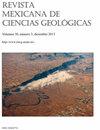Arreglo de fracturas geológicas en rocas miocénicas de la cuenca de México
IF 0.5
4区 地球科学
Q4 GEOSCIENCES, MULTIDISCIPLINARY
Revista Mexicana De Ciencias Geologicas
Pub Date : 2021-03-24
DOI:10.22201/CGEO.20072902E.2021.1.1582
引用次数: 1
Abstract
The study of fracture arrangement is important for the understanding of fluid flow and has a wide application in several areas as slope stability analysis, geothermal fields, deep aquifers and oil exploration. The facture arrangement is an essential characteristic of the spatial distribution of the fractures, although the relation of the spatial arrangement of fractures with variables such as the rock type, the kilometric faults, and structural inheritance is unknowns. We explore de influence of these variables in the facture arrangement through of detail study of Miocene rocks in the Mexico basin. The Miocene rocks in the Mexico Basin are affected by three fracture systems oriented NE-SW, NNW-SSE and ~E-W. All fracture families present a cluster array, where the degree of clustering is related to the rock type that constitute the Miocene volcanic succession (lava flows and volcaniclastic deposits). In addition, the intensity of fracturing is stronger in lava flows than the volcaniclastic deposits, with an inverse relationship to the degree of clustering (Lyapunov Exponent). The F1 family (NE-SW) has groups of fractures characterized by a fractal distribution in mesoscopic scale. Meanwhile, the fractures F2 (NNWSSE) present groups that are associated with mechanical anisotropy in pre-Miocene rocks. This phenomenon is related to structural inheritance and/or reactivation. Finally, the fractures F3 (~E-W) form groups with a random distribution.墨西哥盆地中新世岩石的地质裂缝排列
裂缝布置的研究对流体流动的认识具有重要意义,在边坡稳定性分析、地热田、深层含水层和石油勘探等领域有着广泛的应用。裂缝布置是裂缝空间分布的重要特征,但裂缝空间布置与岩石类型、千米断裂、构造继承等变量的关系尚不清楚。通过对墨西哥盆地中新世岩石的详细研究,探讨了这些变量对裂缝排列的影响。墨西哥盆地中新世岩石受NE-SW、NNW-SSE和~E-W 3个断裂体系的影响。所有裂缝科均呈簇状排列,簇状排列的程度与构成中新世火山演替的岩石类型(熔岩流和火山碎屑沉积)有关。此外,熔岩流的压裂强度比火山碎屑沉积更强,与聚类程度呈反比关系(Lyapunov指数)。F1族(NE-SW)裂缝群在细观尺度上呈分形分布。同时,裂缝F2 (NNWSSE)在前中新世岩石中存在与力学各向异性相关的组。这种现象与结构继承和/或再激活有关。最后,裂缝F3 (~E-W)成组,呈随机分布。
本文章由计算机程序翻译,如有差异,请以英文原文为准。
求助全文
约1分钟内获得全文
求助全文
来源期刊

Revista Mexicana De Ciencias Geologicas
地学-地球科学综合
CiteScore
1.00
自引率
12.50%
发文量
0
审稿时长
6-12 weeks
期刊介绍:
Revista Mexicana de Ciencias Geológicas (RMCG) publishes original research papers on geological processes of broad interest, and particularly those dealing with regions of Latin America. The RMCG also publishes review papers on topics of current interest, and on the geology and tectonics of geological provinces of Latin America. Besides, it offers the opportunity for host editors to publish special thematic issues.
 求助内容:
求助内容: 应助结果提醒方式:
应助结果提醒方式:


